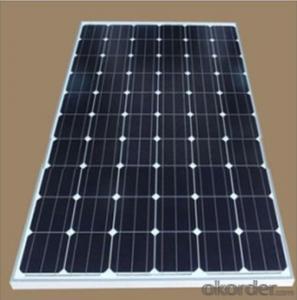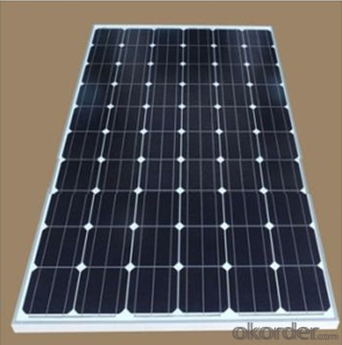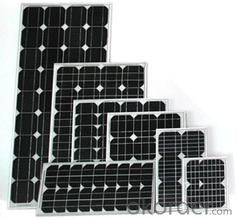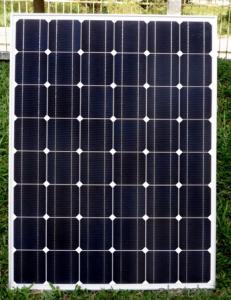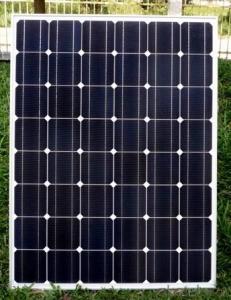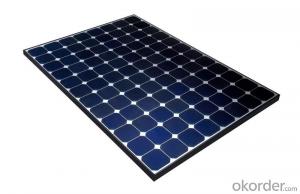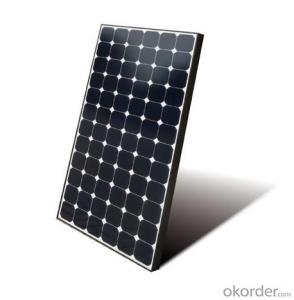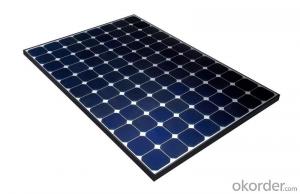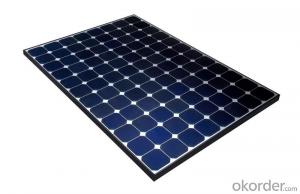Freedom Forever Solar Panels - CNBM Poly 155W Solar Panel with TUV UL CE Certificate for Residential
- Loading Port:
- China main port
- Payment Terms:
- TT OR LC
- Min Order Qty:
- 100 watt
- Supply Capability:
- 1000 watt/month
OKorder Service Pledge
OKorder Financial Service
You Might Also Like
Specification
CNBM Poly 150W Solar Panel with TUV UL CE Certificate For Residential
Introduction
This is a kit using for factory and storage field. This product is a higher output version with stable power and we guarantee you for 20years.
A photovoltaic (in short PV) module is a packaged, connected assembly of typically 6×10 solar cells. Solar Photovoltaic panels constitute the solar array of a photovoltaic system that generates and supplies solar electricity in commercial and residential applications. Each module is rated by its DC output power under standard test conditions, and typically ranges from 100 to 365 watts. The efficiency of a module determines the area of a module given the same rated output – an 8% efficient 230 watt module will have twice the area of a 16% efficient 230 watt module. There are a few solar panels available that are exceeding 19% efficiency. A single solar module can produce only a limited amount of power; most installations contain multiple modules. A photovoltaic system typically includes a panel or an array of solar modules, a solar inverter, and sometimes a battery and/or solar tracker and interconnection wiring.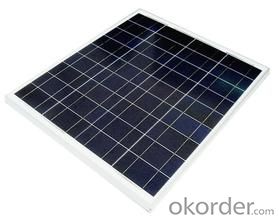
Suggested application
Home lighting business lighting,
Garden lighting, pavement lighting
Farmer household lighting
Decorative water pump
Traffic signal lighting
Industry area
Business area
Solar Power Plant
Product feature
Modules are made of Monocrystalline or Polycrystalline Silicon cell.
Materials and color of the solar panel frame: Clear anodized aluminum alloy type 6063T5 Universal frame; Silver-white color;
The output connection gathers the coupling: Selects conforms to the IEC-612615; 2005, class II, IEC61730 international standard; Airtight waterproofing binding clamp;
Module seal structure: The surface is thick, the high diaphanous rate armored glass with solar cell board special-purpose 3.2mm becomes after the high temperature lamination craft. The back selects has waterproof and anti- aged performance fine TPT materials. The entire block battery board has, the waterproofing, the anti- aging airtight and so on the fine performance;
Power tolerance: +/-3%
Packaging
International standard cartons (according to the requirements of customers)
- Q: What is the main material for making solar panels?
- You can also according to their own needs, according to the power to buy a good package of solar photovoltaic products.
- Q: we are planing to move out of the grid. we need to operate constantly 2 laptops online - does any one can tell us how much solar panels we shall need to make sure of that?
- A laptop is about 70 to 00 W, and you have two. You also may need to power a router, and modem. So, about 50W to 250W contineous should cover it. To save power when not in use, you can let the display go blank. This will reduce your solar pannel, and battery size, and cost. You will need batteries, and blocking rectifier to store the energy for use at night, and a 300W to 400W inverter. Checkout the link below for purchasing solar equipment. You can only hope to get about 8 to 9 hours of full output from your solar pannels, and 80% efficiency. The laptops will be on and using about 200W for the 8 hours during the charging period. So your pannels, need to produce that plus 2 times more than this amount, so you can charge the batteries for the evening, at the same time. So for 24 hour operation, you will need 200W x8hrs for the laptops, plus (6 hours*70W)/8=340W avg. Total of ~540W for 8 hours. Assuming you use power saving modes when not in use, you can probably get away with 3x60W -- 520W to 600W pannel. ( Thuja is right, a few cloudy days may knock you offline) Batteries. A common low cost ( $40) automotive battery can hold about 40 Amp/hours at 2V. Under load, you may get 35 Amp hours at 0V, which is about 350Watts for one hour. You need about 80W avg for 6 hours, or ~ 2900Watt Hours. Which means you would need 9 automotive batteries. Deep storage batteries cost more, but are more durable. 6*00W pannels, $460*6 ~ $2800 Inverter $70 Batteries $400 Battery cables, rectifier, lugs, connectors $50 There are probably some other hidden costs. I was rooting for you, but it appears to be pricey. Another thing you can do, is to use the new energy efficient RF florescent bulbs for lighting. The color and brightness are excellent, and a 60W bulb only uses about 3W, and they last a lot longer as well.
- Q: Can solar panels be used in areas with high snowfall?
- Yes, solar panels can be used in areas with high snowfall. However, it is important to take certain factors into consideration. Proper design and installation can ensure that snow does not accumulate on the panels and affect their performance. Additionally, regular maintenance and snow removal may be required to maximize the efficiency of solar panels in snowy conditions.
- Q: Can solar panels be used in urban areas with limited space?
- Yes, solar panels can be used in urban areas with limited space. There are various options available such as rooftop installations, vertical panels, and solar canopies. These solutions maximize the use of limited space and allow urban areas to harness solar energy efficiently.
- Q: I have a 2 volt deep cylce Everstart battery with 845 cranking amps, and a Grape Solar GS-S-250-Fab5 250-Watt Monocrystalline Solar Panel . I use them to power a 48Flat screen TV, a Roku, my 65 watt consuming MacBook Pro, and a 65 watt Fan.I know from previous experience that just the battery, an inverter, and the fan, that the fan will blow for 0 hours straight.Should I really be concerned with a Charge Controller?
- Should I really be concerned with a Charge Controller? Yes. The main purpose of the charge controller is to protect the battery from over charging. Over charging reduces battery life. And spending extra money for a MPPT type controller will get more more useable power out of your solar panel. Would another battery of the same magnitude be helpful in preventing an accident? How much storage capacity does your current battery have (measured in kWH)? A ~$20 Kill-a-Watt meter would take a lot of uncertainty out of how much power you actually use. Even deep cycle batteries suffer reduced battery life from deep discharges. The battery sounds too small for the loads you describe so I would think you would want more. ---------------------------------------... After reading the other answer In a nutshell, with your small 2 volt starting battery, 24 volt panel and a mix of unknown loads, (which is correct), I thought I would elaborate. I had not considered the possibility that you bought a 24 volt panel for your 2 volt battery. Hooking the panel you bought directly to the current battery is a horrible idea. I you were lucky it would just cook the battery in a short period of time. You basically bought the wrong type of panel for a 2 volt system. I assume that there are no controllers on the the market for this situation. If that's the case, I don't know of any good way match the 24v panel to the 2 volt battery.
- Q: If I wanted to put some solar panels on my roof, how many would i need and how many watts would they have to be to be able to power my whole house?
- Actually even if you cover your whole roof with panels, you wont get enugh power to even run a tv, fan and light at the same time. Solar panels give out a very less power output.
- Q: all i want to do is provide enough electricity for 2 fluorescent bulbs i was looking at some 80 watt panels how many of those would i need and what else do i need for storing the electricity for use at nite? and how much would it all cost?
- The solar panels are made in China because there are fewer environmental regulations and cheap coal power. It takes a lot of energy to melt silicon and there are toxic waste products. It would be three to five times more expensive to make the panels in the US ( three times is just for reprocessing the toxic wastes ). Solar cell made in China are about $2 a watt, perhaps as low as $ a watt but in truth the claims for $ a watt or less solar panels as in thin film solar panels have much lower efficiency and require perhaps ten times more surface area.
- Q: Can solar panels be damaged by hail or other weather conditions?
- Yes, solar panels can be damaged by hail or other severe weather conditions such as strong winds, heavy rain, or snowstorms. Hail can cause cracks, dents, or shattered glass on the surface of the panels, reducing their efficiency or rendering them completely ineffective. Additionally, extreme weather events like hurricanes or tornadoes can also cause structural damage to the mounting system or dislodge the panels from their position. Therefore, it is important to consider the weather conditions in a particular location and choose appropriate measures to protect solar panels from potential damage.
- Q: Can solar panels be used for powering agricultural irrigation systems?
- Yes, solar panels can be used to power agricultural irrigation systems. Solar-powered irrigation systems are increasingly being used in agriculture as they provide a sustainable and cost-effective solution. Solar panels convert sunlight into electricity, which can then be used to power pumps and other irrigation equipment, reducing reliance on fossil fuels and electricity grids. This approach helps farmers save on energy costs and reduces their carbon footprint.
- Q: what kind of degree do i need to get in order to know everythin about installing solar panels for houses?
- The only degree you will need is a degree in hard knocks.You will get it from a reliable contractor who has the skill and knowledge with the product.You may want to call the manufacture and see if there any in house schools that you could attend and be certified in their product.
Send your message to us
Freedom Forever Solar Panels - CNBM Poly 155W Solar Panel with TUV UL CE Certificate for Residential
- Loading Port:
- China main port
- Payment Terms:
- TT OR LC
- Min Order Qty:
- 100 watt
- Supply Capability:
- 1000 watt/month
OKorder Service Pledge
OKorder Financial Service
Similar products
Hot products
Hot Searches
Related keywords
